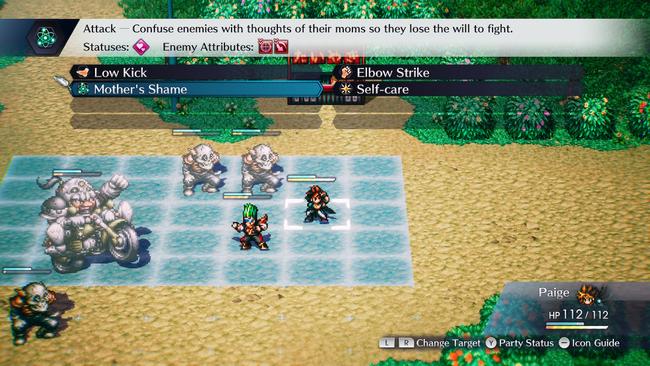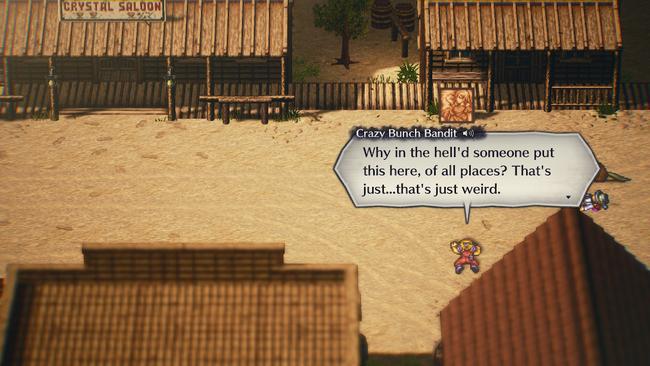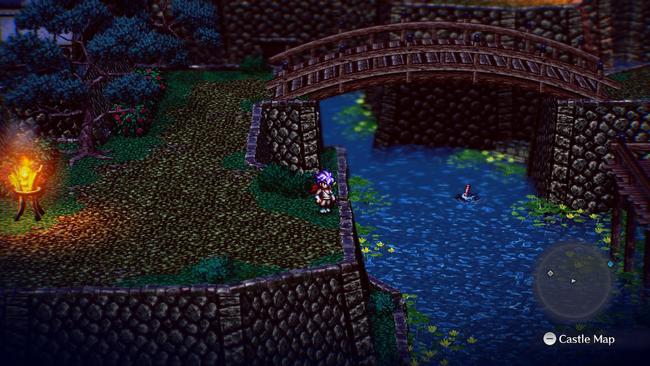Live A Live Review
The Live A Live remake is a surprise - and in more than one way. Its existence at all is the first big shocker - a largely forgotten stand-alone SNES-era RPG that was never released outside Japan, it felt like a game likely to be lost to time. Nintendo and Square Enix pleased everyone by revealing the game was to get the HD-2D treatment, and also that it was coming out really soon. But the biggest trick Live A Live has up its sleeve is what a delight it is.
I went into the game largely blind. While other, more elderly contributors to RPG Site gushed about Live A Live’s importance, I hadn’t even heard of it prior to its announcement. It is, after all, a year older than me. This also meant I went into this review with unclouded eyes - free of the scourge of the rose tint. It also meant I could go in and be surprised by this experience in other thrilling ways.

Live A Live has one core gimmick that separates it from other RPGs of its era: you get to play as several different heroes at different points of time and places on Earth (and beyond). Each character has their own enclosed story with no carry-over between them, though as you progress you’ll begin to notice some common threads. You can start with any one of seven chapters and tackle them in any order - though it’s no spoiler to say that once you complete them all, some additional hidden chapters appear that will begin to draw disparate story threads together.
While what you do as the different heroes can vary from chapter to chapter, the game’s combat systems are largely the same throughout. At first glance, it seems to be your typical grid and turn-based combat with buffs, debuffs, weaknesses, and party members. However there’s a total lack of skill or magic points, and instead, your “turn” is determined by a bar that fills as characters move or use abilities. Certain attacks will require more charge time, and these can be interrupted if the charger is moved or hit with a strong attack. It sort of feels like a hybrid between a turn-based or active time battle system with elements of tactical RPGs.
Occasionally victory conditions in battle will be shaken up, as some enemies will flee if their leader is defeated. Certain enemy patterns are built around this mechanic, such as a weaker enemy having surrounded themself with self-destructing machines.

When a party member is knocked out, a little halo will appear above them, which means they can still be healed and return to the fight. However, if they take another hit in this state, they’ll be out of the match completely and the enemy AI knows this, so it’s important to keep party members within range of each other to avoid losing units in battle.
I know some don’t enjoy the stylized appearance of having small main characters and gigantic detailed enemy sprites, but in this game they have a functional purpose, too. Larger enemies will take up more spaces on the grid, not only potentially blocking your way but also leaving themselves more vulnerable to attack from more positions. This is especially useful for certain moves that can place effects on specific tiles which will inflict damage to those standing on them.
The biggest difference in combat from one chapter to the next is actually in terms of how much fighting you do. Some chapters are totally void of random encounters, for instance, with only mandatory story battles. Others are a more standard affair, like mini self-enclosed RPGs complete with random battles and at least a small amount of grinding required. Your health does recover between encounters, however, and making use of items within battle is important. With the exception of optional bosses and only a scant few other moments, I found the game quite easy overall - probably in part due to how the various chapters in Live A Live can be tackled in any order you like. Some are harder than others, but any one is a suitable first choice.
One of the few additions in the remake over the SFC original is an optional radar with objective markers. While some might find it makes the game a bit too streamlined, Live A Live is not afraid to take this away at important moments in order to force you to figure out something yourself. Other modern additions, such as sparklies to show where items are, seeing the area of effect of your attacks, the option to skip cutscenes, and multiple save slots, are well appreciated.
As mentioned in my preview, it isn’t all attack bars and levels. Certain chapters have unique gameplay gimmicks, such as setting up traps within a time limit or having the option to sneak your way around instead of fighting. One chapter is almost entirely story-focused, while another features a straight series of fights and nothing else - meaning the entire scenario lasts little more than half an hour. There are also a couple of chapters that utilise a crafting system to help you create better equipment, which was fun, but I appreciate that it wasn’t forced into every single adventure.

Throughout Live A Live, there are several secrets and optional objectives, such as especially strong bosses. These are the meatiest, most engaging pieces of gameplay for those who are genre veterans and really want a challenge. There is incentive in replaying parts of the game, too, such as to get all (or none of) the kills in the Edo chapter. During replays, other small changes may appear too, such as when I did a rematch and witnessed a scene I hadn’t before, where someone in the crowd threw rubbish at The Great Aja who then jumped out of the fight to confront the assailant.
Initially, Live a Live is an anthology of short stories of varying genres, such as sci-fi horror or martial arts movies. A few scenarios are particularly basic, moreso the shorter ones. I found a lot of them perhaps lean in a bit too much into taking from direct inspiration rather than standing much on their own. That said, I did like some sentiments of the various tales. Most of the stories take themselves seriously, even the more outlandish ones like The Near Future, but there is humorous dialogue to be found in all of them.
Once you’ve completed all seven basic scenarios, a special eighth unlocks. I personally think this chapter probably had the strongest story, even if certain aspects were quite predictable. Once the eighth chapter is finished, there is - you guessed it - a ninth! This is the final piece of the puzzle, and brings the lead characters from each of the previous stories together for one final showdown.
This is naturally really exciting and satisfying to see, after spending time with these characters in their own stories and time periods - but it’s here that the game’s almost thirty-year age begins to show itself. Specifically, it brings these characters together… but they don’t really have much to say to each other. Interactions are kept to a minimum. Of course, two of the characters can’t even talk, so it’s perhaps not that fair, but since the narrative is such an important element to this game, I wish the final chapter had a little more punch.

The application of HD-2D makes this game absolutely gorgeous; some fights in particular really make use of the modern effects to make Live A live look as I suspect was originally intended. Everything is in a 3D environment with pixel art laid atop, though the mountainous areas are probably the least attractive. The added lighting and depth make this game look utterly phenomenal. All characters and enemies are still made of hard pixels, but they retain their size and detail outside of battle.
Due to the pixel art, Live A Live still has a retro-feel, and I could really appreciate the design and lighting. Since the characters are all sprites, some of the cutscene animations can look a little silly, though the game also has its fair share of unique sprite animations brimming with charm, right down to a guy taking the literal shirt off his back for you. One little touch I like is that the backgrounds in the loading screen look different based on your location in each chapter.
One of the most enduring and famous elements of the original SFC release, even outside Japan, is Yoko Shimomura’s soundtrack. The boss theme from Live A Live, Megalomania, took on a life of its own and was the direct inspiration for Undertale’s much-loved Megalovania. The soundtrack is intact, but has been rearranged. Just as with the story and certain mechanics, every chapter has its own signature sound - which allowed Shimomura to unleash her full talents, much as she did composing themed music for each country in Street Fighter II.
The result is phenomenal, which is why the soundtrack’s fame has endured even in the years when Live A Live fell into obscurity. No longer constrained by musical limitations of SFC hardware, this new version of Live A Live pulls no punches, such as using traditional instruments where previously iffy synth had to do, or even by adding real vocals and, in the case of the cowboy chapter, authentic-sounding wild west whistling. The Steel Titan theme was enhanced to the extent of adding vocals by Hironobu Kageyama to really give it an anime theme song feel. Of course, the general boss theme is the best of them all.
Initially, I wasn’t so impressed by some of the English voice acting, whether it was a few poor performances or questionable accents - especially in the chapters set in Asia. I think one voice actor was going for an Australian accent but couldn’t quite hit the mark (to my Australian ear, at least). Most of the rest of the cast were actually quite good, with all major characters speaking the vast majority of their lines.
One baffling omission in this remake is the lack of any way to increase the speed of battle animations. This is a common quality-of-life feature in SNES-era RPG remakes, so it’s frustrating to find that not an option here. Otherwise, the game’s performance on Switch is overall solid; I played largely in docked mode, but very rarely had any performance issues. The loading screens went fast enough I couldn’t read the tips or character info most of the time - though once you’ve completed a chapter you can read that info in the menu.
With modern touches and enhanced visual depth and style, this remake is the ideal way to experience Live A Live, though this is coming from someone who hasn’t played the original. I enjoyed playing through the various stories, experiencing both the differences in gameplay and narrative style. While the story overall isn’t a literary masterpiece, the tales are worth experiencing, even if when they all come together it doesn’t mesh as nicely as I’d have hoped.
The game didn’t wear out its welcome with my playthrough, taking me about 23 hours to get all the endings. Live A Live brings with it some of the best qualities a game can have, a sense of discovery and adventure. With the option to play some chapters completely differently, or tackle on extra hard enemies, this is definitely a game I’ll replay, sooner than later.